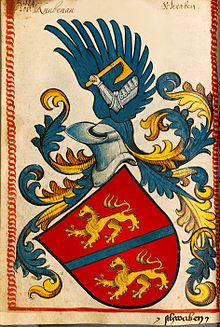Knabenau
This article includes a list of general references, but it lacks sufficient corresponding inline citations. (July 2023) |

The House of Knabenau or von Knabenau (also known as Barons von Knabenau) is an ancient Baltic-German noble family of German origin, originally from Silesia, and later it spreads in the 16th century in Courland.
History[edit]
The family of Barons von Knabenau belong to the sideline of the Swabian Counts von Kyburg whose ancestor was Gotfried from the Agilolfing dynasty and to the highest class of ancient Silesian and Courland nobility (German:Uradel). First time the family von Knabenau was mentioned on May 2, 1147 with knight a Gotthard de Knabenau. The following mention refers to August 5, 1234, where Bishop of Wrocław, Thomas I, calls Johann Ludwig von Knabenau the knight of Duke Henry II the Pious, Duke of Silesia. In addition to Johann Ludwig, many other family members were already known as landowners in the 13th century. From 1271 to 1278 for the Imperial Vogt Johann von Knabenau was granted temporary possession of the land and Bolków Castle , which became the headquarters of the Barons von Knabenau from the Duke of Bolesław II the Bald. The unbroken family line begins with knight a Hartvig von Knabenau, who is named in documents between 1454 and 1456. He was at the castle in Brandenburg during the siege. In 1620, Johann, Friedrich and Otto von Knabenau, signed an agreement and sealed the document about land ownership with the Archbishop of the county Piltene and with the Teutonic Order. Captain of the Knights of von Knabenau, distinguished himself in the rescue of Vienna from the Turks in 1683. The Diploma of Polish King John III Sobieski of 1685, Captain von Knabenau with his descending offspring's, in the Kingdom of Poland set to in baronial dignity. In the decree on the resignation of December 31, 1822, Colonel Friedrich Johann von Knabenau was named as Baron. Judgment of 05/16/1841, at approved the introduction in which noble family von Knabenau, natives of the county Piltene (Courland), allowed to be officially was matriculated in Courland knighthood. Baron dignity approved for name von Knabenau, government decrees Senate Courland noble Committee of 10 June 1853 and 28 February 1862 in pursuance of the Supreme Decree of 10 June 1853 and 28 February 1862 years (see the statement of the Senate 1853,1862).
Possessions[edit]
- Bolków Castle, Poland, ancestral seat
- Neu-Sallensee Manor, purchased in 1839 and Groß-Born Manor in Courland (now Latvia)
- Bagdoniškė Manor; Berghof Manor, acquired by Johann Friedrich Otto Baron von Knabenau in Vilna Governorate (now Lithuania)

References[edit]
- von Knabenau in the All-Russia genealogical tree (in Russian)
- Erik-Amburger-Datenbank – Datensatz anzeigen, von Knabenau (in German)
Notable family members[edit]
- Friedrich Baron von Knabenau (1651 – d.) Baron, was a Swedish colonel and member of the Privy Council
- Johann Friedrich von Knabenau (?-d. 29/10/1845) – Baron, Dec. 1815 staff-captain Novgorod cuirassier regiment; August, 1817 captain of the L.- Guards Hussars; in October, 1817 transferred to lieutenant colonel in Starodubsky Cuirassier Regiment; later on Retired Colonel (retired by decree on December 31, 1821). Taught high school students in the dressage arena on horseback courtiers reserve squadron in Tsarskoye Selo Lyceum (1816–1817)
- Georg Gotthard (Jerzy) von Knabenau (1723–1798) Baron, the captain of the troops of the Crown (1760). In 1764 he supported the candidacy of Stanislaw August Poniatowski to occupy the throne of the Commonwealth. From 1765 – Colonel troops crown. In 1767, he was close to the king and became his chamberlain. Commander of the Order of St. Stanislaus 1789. Died in Warsaw in 1798.
- Dorothea von Knabenau (de Chassepot de PISSY, countess)(1779–1848) was maid of honor of the Duchess of Courland. Johann Wolfgang von Goethe was in love with her.
Sources[edit]
- Neues allgemeines deutsches Adels-Lexicon
- Carl Arvid Klingspor: Baltisches Wappenbuch. Stockholm 1882, S. 48–61
- Scheibler'sches Wappenbuch, älterer Teil Jungingen Date 1450 – 1480 [1]
- Georg Gotthard (Jerzy) von Knabenau [2]
- Dorothea von Knabenau (de Chassepot de PISSY, countess) [3] [4]
- Johann Friedrich von Knabenau (?-d. 29/10/1845) [5]
- Bruno W. Häuptli (2007). "Thomas I. von Breslau (Neiße)". In Bautz, Traugott (ed.). Biographisch-Bibliographisches Kirchenlexikon (BBKL) (in German). Vol. 27. Nordhausen: Bautz. cols. 1405–1409. ISBN 978-3-88309-393-2.
- Roman W. Brüschweiler, Stammtafel der Häuser Lenzburg, Kyburg und Dillingen S. 108–109; in: Geschichte von Wettingen
- P. Brau, Gesch. der Gf.en v. Dillingen und K., Hist. Abh. der Akad. München 5, 1823
- C. Brun, Gesch. der Gf.en v. K. bis 1264 [Diss. Zürich 1913]
- M. Feldmann, Die Herrschaft der Gf.en v. K. im Aaregebiet 1218–26, 1926
External links[edit]
- Barons Von Knabenau (in Latvian)
- Barons von Knabenau (in Russian)
- Barons von Knabenau (in Polish)
